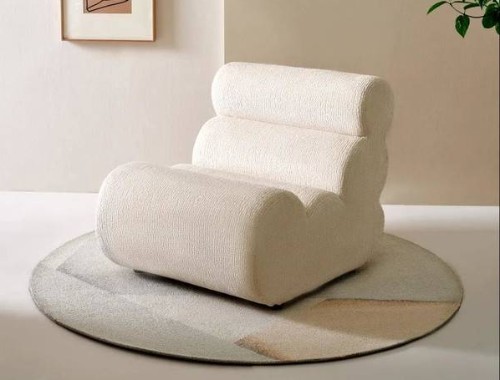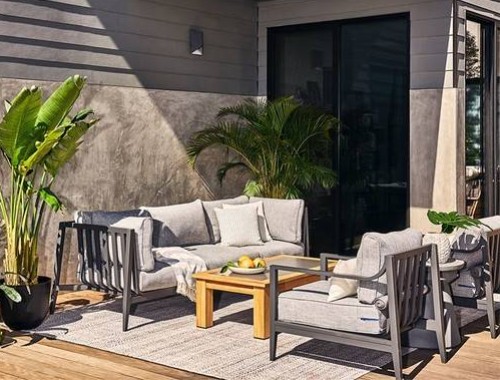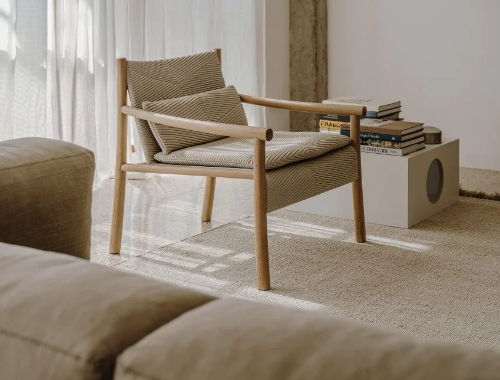Salone Internazionale del Mobile 2011:LEMA
Every project is the symbol of profound dedication to quality and excellence: this is Lema. The common denominator that runs through all the furnishings is comfort, the harmony of slow living via soft colours for the most relaxing of settings, or more lum
Every project is the symbol of profound dedication to quality and excellence: this is Lema. The common denominator that runs through all the furnishings is comfort, the harmony of slow living via soft colours for the most relaxing of settings, or more luminous tones for places that are venues for social, lively moments. Thanks to Lema, sunny, Mediterranean atmospheres enter the home through a fine balance between lines, colours and materials. The rooms become intimate, harmonious places in which to spend moments of simplicity with those closest to our heart, because it is this that makes a home the centre of all the truest emotions.
A home furnished with Lema brings a touch of freshness and carefreeness even in town, giving a sense of the pleasure of spending free time in a space in which daily routine gives way to the rest of life, to the things that matter most and make our days pleasant and serene. The great variety of details, colours and finishes help to delineate the soul residing in the Lema catalogue in different houses that all share a way of understanding a setting and the way it is lived. Homes that want to safeguard the best moments in life.
The crafts traditions of the past, which have made Italian design the undisputed leader in the world, find in Lema one of their finest expressions, combining with a large industrial reality. Over the years, the company has developed a high-level research centre that has made it possible to bring together care for detail and the most modern forms and cutting-edge industrial production processes.
The strength of Lema lies in its having succeeded in declining the crafts history of the industry of furniture in a modern key: the creation of the system with load-bearing side panels and of the wardrobe are the symbols of this development which this year, on the occasion of the Salone del Mobile di Milano, sees the presentation of the double-panel glass doors. Two plates of glass linked by a frame of the same material to give rise to a light, transparent door for systems, and combining the clarity of glass with a low weight hitherto unequalled.
The 2011 Salone provides Lema with the opportunity to present its new walk-in closet, designed by Piero Lissoni, a combination between the classic one with panels and rack and the self-supporting one, thanks to the insertion of uprights supporting the internal fittings.

Much stress in the spaces at the fair is laid on the new collaborations: Francesco Rota with his essential approach that is also warm and sunny; the studio Charlie, young Italian designers with an ironic yet rigorous stance; David López Quincoces and his minimal, elegant line. Among the new collaborations is one with the Japanese Nendo studio, one of the most avant-garde creative studios of recent years: not just the Shift wall bookshelf presented on the stand in the fair, but also the Zigzag modular bookcase, present in all its forms in the Interni Mutant Architecture & Design exhibition at the Università Statale di Milano. These new collaborations match the historic ones with Piero Lissoni, Roberto Lazzeroni and the Studio Kairos, whose products have become veritable icons for Lema and its public.
The fairgrounds at Rho Pero will this year also host a stand in which Lema exhibits the best of its production, thanks to the layout by its artistic director, Piero Lissoni. A wide range of products in which the neutral colours of the floor and walls provide a natural frame to the colours of the furnishings with gloss and matt finish and delicate lines, but with the firm character of the furnishings, systems, wardrobes and walk-in closet. The space in the fair is divided into nine spaces describing different ways of experiencing the night and day zones, which both share a vision, a philosophy that is typically Lema: the home in which the experience the most pleasant moments of a day. The exhibition is rounded off with the display of wardrobes, with the widest variety of doors and accessories, and the two new walk-in closets including the latest innovations for the rationalisation of space and the composition of the structure that can be perfectly adapted to the requirements of the consumer and of the spaces in his home.

Room A
The protagonist of this dining area is the Filo table by David Lopez Quincoces: a rigorous and elegant design for a table formed of slender legs of sheet metal welded to a frame of the same material. Within this frame, a top of sheet metal or marble complete the line of this sculptural and hieratic piece. Around Tito, the Hati armchairs and chairs by Piero Lissoni; forms that recall those of certain seats of the past, redesigned to highlight their structure and exalt the proportions. The black oak structure of the little armchairs blends harmoniously with the burnt red fabric covering; the chairs, on the other hand, are of natural oak covered with brick-coloured fabric. The walls are decorated with 3 Totò units by Studio Kairos: shelves in folding of an almost extreme simplicity; the paper colour contrasts with the white wall, creating a delicate movement filling the room. Another novelty for 2011 is the Conchiglia sideboard by the studio Charlie, young designers whose skills Lema has employed for this Salone del Mobile. The linearity of the container is interrupted by a succession of doors and drawers in square that become increasingly small creating a sort of virtual spiral concluding in an empty space that aims to be the origin and end of this movement. And finally, a Selecta system by the Lema Research and Development Centre, the system with load-bearing side panels par excellence: the system is shown with a neutral, discreet paper white finish and with a sliding door in double-glazing glass, the new closing system by Lema which imparts a further breadth and simplicity to the composition thanks to the extra-light glass and lightness of the door.

Room B
The Plain bookcase dominating this second room is by Francesco Rota. A light structure in square-sectioned steel tubing painted white or black and available in two different thicknesses; a case of rigorous lines with shelves of different lengths in natural larch or painted in Lemacolortrend colours. The modular nature of this unit makes it ideal for every requirement for space in the home. The opposite wall, instead, houses the T030 system by Piero Lissoni: a group of modules of different dimensions, colours and combination of full and voids which can be assembled in classic, contemporary, linear and asymmetrical compositions. This composition in paper colour with open grid and elements and interior in moka-coloured larch is highlighted by the frame in paper white.
At the centre of the room, the Nixy table by Lisson, of a minimal, square look, and which can be extended to a length of 280 cm. For the Salone 2011, Lema presents the Nixy table in light-coloured larch and in the more material brushed dark wood finish, surrounded by Hati chairs and armchairs with orange-coloured fabric, bringing a touch of sunshine into the dining area.

Room C
The dominant carbon paper blue of the Hati armchairs by Lisson stress in contrast the wooden elements in the Levìc table by Gabriele and Oscar Buratti: a solid larch Moka structure framing a top of the same finish. The Totò modular units by the Studio Kairos in blackboard black impart a contemporary touch to the setting, which is rendered more precious by a paper-coloured T030 system. A cosmopolitan, modern and contemporary setting but nevertheless warm and welcoming as only Lema succeeds in being.
Room D
The night-time accommodation as seen by Lema: protagonist of the room is a capacious wardrobe built on two levels. The paper colour is further highlighted by the hinged door, which through the nature of its finish imparts a natural touch on the room. A spiral staircase separates the mezzanine from the ground floor at the centre of which is Edel, the new bed by CRS Lema. The curved wooden bed head is padded and lined in fabric: green/beige for the front and bordeaux for the rest, providing a chromatic contrast that is modern yet simple and further enriched by a hem in apple-green ribbed fabric. The eggplant-coloured edging around the bed also makes use of contrast for effect. This is a bed of retro taste which, thanks to its colours, enlivens the bedroom. The matching Flowers tables are perfect both as bedside tables and as small tables for the day area: petals of coffee and milk-coloured wood over a light metal structure, designed by Roberto Lazzeroni.
Opposite the bedroom is a study dominated by the paper-white Selecta system. With the versatility of modules and many finishes, this ideal system adapts to the most varied styles but maintains a strong Lema identity, marked by quality and craftsmanship. The Victor writing desk, of typical 1940s look, appears as a black oak structure with blackboard-coloured top, to give this space an important character. It contrasts with the Lucy armchair, a seat offering soft, welcoming lines in white leather over a black oak structure.

Room H
The dining room in its most classical manifestation: the broad Jump table with metal structure and lacquered top gives a touch of that design of the past that is the trademark of Roberto Lazzeroni’s production for Lema. Complementing the table are Lissoni’s Hati armchairs in brushed Carbone oak, lined in mustard-coloured fabric, or in natural oak and burnt sienna fabric. The dining area with warm colours is highlighted by Lazzeroni’s new Rainbow sideboard, a classic piece reinterpreted that makes use of the same supports as the Jump table with structures and doors in different colours (Avio, Sabbia, Cacao and Grafite) resembling the nordic style.
The room is rounded off with the white-coloured T030 system in metal; simple, elegant and contemporary.

Room L
The bookcase as interpreted by Lema: two wide walls completely occupied by the Selecta system. Lema presents the new finish of the structure in dark brushed oak that highlights the material of the surface and gives the spaces that natural yet solid touch that luxurious bookcases of the past had. The transparent double-glazed glass door adds a precious touch to the composition with back boards in a matt lacquered Ombra finish and prominent elements in a shiny lacquered Nocciola colour.

Room M
A second bedroom, in which the protagonist is the new Dream View bed, designed by Roberto Lazzeroni. The form of the irregular bed head imparts a relaxed, casual look on the room, one that is modern and at the same time harks back to the styles of the past. The dark-blue upholstery highlights the bed in contrast with the neutral colours of the room and transforms it into an iconic element for the bedroom. Complementing the bed are the Sign tables by Studio Kairos, all with a bronze base and painted round top in Paper, grey, Alga, neutral and dark larch colours; simple furnishings but with a great graphic force. The same force as can be seen in the Shift wall systems by studio Nendo: frames of white wood enclosing shelves at various levels, creating a harmonious movement and fulfilling a fully functional role of containment. The cupboard with hollow hinged Conca doors acts as a backdrop to this setting: the Carta-white exterior matches the internal structure and white melamine fittings to give light and freshness to this room.
Room N
The fulcrum of this space is the Per Pam Pum table by Marc Sadler, an ironic and colourful piece that has become a veritable Lema icon. The primary colours of this fun furnishing are highlighted thanks to the paper white of the Selecta system and white glass door. On the opposite wall, a composition of the T030 system with bench and panelling in oak, the grid exposed and paper-white wainscot. And finally, the turning Totò containers, which revolved around a hinge and offer a closed space in which to place books and objects.
Within the Lema space, Piero Lissoni has designed a made-to-measure zone for the presentation of the new features of the cupboards and the new walk-in closet. This year, Lema is for the first time presenting the Traccia sliding door: with material finish, in which the wood becomes the protagonist thanks to a porous texture that gives a natural touch to the room, highlighting the quality of the raw materials used by the company for all its products. A second new feature in the cupboards catalogue is the handle on the door of the coplanar cupboard, which until now had only a flush-fitting handle: this small functional detail is also an aesthetic sign and makes it possible to broaden the consumer’s choice.
Finally, the Hangar new walk-in closet that appears alongside the historic ones in the Lema catalogue. Designed by Piero Lissoni, it adds to the wood and backlit glass wall panels the use of uprisings floor/ceiling which help surrecting the weight of the internal fittings.
the structure of the panels is designed so as not to lean against the walls, a crucial detail for all constructions not built in masonry; this ensures that Lema is the ideal partner for architects working in markets in which the walls of houses are light, as in the United States. The weight of the panels comprising the walk-in closet is divided between the rack and the uprights that support the internal fittings. Moreover, the rear panel in opaline glass, which gives a soft, diffuse luminosity thanks to backlighting.
Lema is not solely for the home: the group dedicates a specific production sector to the contract world – Lema Contract – which works in close contact with designers to create ad-hoc solutions. From Multi-apartments to retail outlets, hotels to corporate venues, Lema offers made-to-measure solutions through the work of the technical department which receives the specifications from the architects and translate these into products. Lema’s contract work is the fruit of the skills of its in-house technicians and of the company’s history, as well as of its great production capacity, employing the latest technology to meet the requirements of its clientele. It is also possible to use products from the Lema catalogues and add these to the made-to-measure solutions to complete the desired settings.
-

Quanyou teamed up with the fashion brand ANNAKIKI to launch a new joint product!
-

Outer, an outdoor furniture brand founded by Chinese, enters the Australian market
-

National Bureau of Statistics: The retail sales of furniture in the first three quarters reached 120.5 billion, an increase of 20.7%
-

Enveloping lounge chairs and lightweight office chairs from Arper feature

 沪公网安备31010402003309号
沪公网安备31010402003309号



